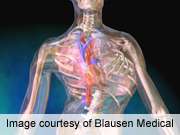Classification rule IDs four risk groups in scoliosis progression

(HealthDay) -- The risk of curvature progression in patients with adolescent idiopathic scoliosis (AIS) can be based on initial angle of curvature, age, menarcheal status, and height, according to a study published online June 25 in The Spine Journal.
To determine risk factors for curve progression, C.F. Lee, Ph.D., from the University of Hong Kong, and colleagues retrospectively examined 2,308 patients (10 years and older) with untreated AIS, a Risser sign of 2 or less, and a curvature less than 30 degrees at presentation.
Based on time to progression to 30 degrees, the researchers identified four risk groups. Those with an initial Cobb angle of 26 degrees or more were at highest risk (hazard ratio [HR], 8.8), while those with an angle less than 18 degrees were at lowest risk (HR, 1.0). The two intermediate risk groups were based on curvature, age (more or less than 11.3 years), menarcheal status, and body height (more or less than 154 cm).
"In conclusion, through our classification system, health care management of AIS patients can be made more efficient by using the clinical information collected at their first presentation at or after the age of 10 years to determine the course of treatment," Lee and colleagues write.
One author disclosed financial support from Synthes and Ellipse Technologies.
More information:
Abstract
Full Text (subscription or payment may be required)
Copyright © 2012 HealthDay. All rights reserved.
















